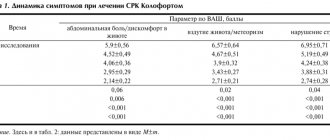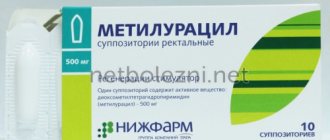Ovipol Klio
HRT for the treatment of symptoms of estrogen deficiency should be carried out only for symptoms that adversely affect the woman’s quality of life. At least once a year, a thorough assessment of the benefit-risk ratio should be carried out; continuation of therapy is justified only if the benefit of using the drug exceeds the risk. There is limited evidence of the risks associated with HRT when treating premature menopause. Due to the low absolute risk in younger women, their benefit-risk ratio is more favorable than in older women.
Medical examination/observation
Before starting or resuming HRT after its interruption, it is necessary to collect a detailed individual and family history, conduct a general and gynecological examination (including examination of the mammary glands and pelvic organs). During the therapy period, it is recommended to conduct periodic medical examinations, the frequency and nature of which are determined individually. The woman should be informed about the need to inform the doctor about possible changes in the mammary glands. Screenings, including appropriate imaging modalities such as mammography, should be performed according to currently accepted screening standards and on a case-by-case basis.
Reasons for immediate discontinuation of therapy:
Therapy should be stopped immediately if a contraindication is identified and if the following conditions occur:
- jaundice or deterioration of liver function;
- significant increase in blood pressure;
- the occurrence of migraine-type headaches;
- pregnancy.
Hyperplasia and endometrial cancer
To prevent stimulation of the endometrium, the daily dose of estriol should not exceed one administration (0.5 mg of estriol) per day. This maximum dose should not be used for more than 4 weeks. One epidemiological study found that long-term, low-dose oral estriol may increase the risk of endometrial cancer. The risk increases with the duration of treatment and returns to baseline values one year after discontinuation of the drug. Basically, the risk of developing minimally invasive and highly differentiated tumors increases. If spotting/bleeding from the vagina occurs, an appropriate examination is necessary. The patient should be informed of the need to contact the attending physician if bleeding begins.
Mammary cancer
Long-term use of HRT increases the risk of developing breast cancer in women receiving combination therapy with estrogen and progestogen and, possibly, estrogen monotherapy. In women receiving combined estrogen + progestogen therapy for more than 5 years, there was a 2-fold increase in the risk of developing breast cancer.
With estrogen monotherapy, the increase in risk is significantly lower than when combined with a progestogen. Limited data indicate that there is no risk of developing breast cancer with the use of estriol.
HRT, particularly combination drugs, may increase the density of mammographic images. This may complicate radiological detection of breast cancer.
Ovarian cancer
Ovarian cancer develops much less frequently than breast cancer. Long-term estrogen monotherapy (for at least 5 to 10 years) was associated with a small increase in the risk of ovarian cancer. Some studies suggest that HRT with combination drugs has a similar or slightly lower risk. It is not known whether the risk of long-term use of low-potency estrogens (such as estriol) is different from that of monotherapy with other estrogens.
VTE
HRT is associated with an increase in the risk of developing VTE (deep vein thrombosis or pulmonary embolism) by 1.3-3 times. The likelihood of developing VTE is higher during the first year of HRT use than at a later date. In patients with a confirmed thrombophilic condition, the risk of VTE is high, and HRT may further increase this risk. Therefore, HRT is contraindicated in such women.
Generally recognized risk factors for VTE include estrogen use, older age, major surgery, prolonged immobilization, obesity (BMI > 30 kg/m2), pregnancy/puerperium, systemic lupus erythematosus, and cancer. There is no consensus regarding the possible role of varicose veins in the development of VTE. After any surgical intervention, VTE prophylaxis is necessary. In case of prolonged immobilization due to planned surgery, HRT should be temporarily discontinued 4-6 weeks before surgery and resumed only after the woman has regained full mobility.
In the absence of a woman's history of VTE, but in the presence of thrombosis at the age of less than 50 years in close relatives, it is recommended to conduct a screening examination, having previously discussed all its limitations (screening can only identify a number of thrombophilic disorders). If a disorder is detected that does not correspond to the disease in relatives, or if a “severe” defect is detected (for example, deficiency of antithrombin III, protein S or protein C, or a combination of these defects), HRT with estriol is contraindicated.
For women receiving long-term anticoagulant treatment, careful consideration of the benefit-risk profile of HRT is required.
If VET develops, therapy with Ovipol Clio should be discontinued immediately. A woman should be informed of the need to immediately consult a doctor if possible signs of thromboembolic complications appear (for example, swelling or tenderness along the vein of the lower extremity, sudden chest pain, shortness of breath, etc.).
IHD
There is no evidence from randomized controlled clinical trials that combined HRT or estrogen monotherapy can prevent myocardial infarction in women with and without coronary artery disease.
Estrogen monotherapy
According to randomized controlled clinical trials, in women with a history of hysterectomy, the risk of coronary artery disease is not increased with estrogen monotherapy. The absolute risk of coronary heart disease increases slightly with HRT with combined (estrogen + gestagen) drugs in patients over 60 years of age.
Ischemic stroke
HRT with combination drugs and estrogen monotherapy are associated with a 1.5-fold increase in the risk of ischemic stroke. The relative risk does not change with age and time after menopause. However, the baseline risk of stroke is more dependent on age, and the overall risk of ischemic stroke with HRT increases with age. The risk of hemorrhagic stroke does not increase with HRT.
Other states
Estrogens can cause fluid retention, and therefore patients with chronic heart and kidney failure should be under close medical supervision.
Estriol is a weak gonadotropin antagonist and has no other significant effects on the endocrine system.
It is necessary to monitor lipid levels in patients with pre-existing hypertriglyceridemia because, in rare cases, estrogen HRT has caused a significant increase in plasma triglyceride concentrations, leading to the development of pancreatitis.
Estrogens cause an increase in the concentration of thyroxine-binding globulin, which leads to an increase in total circulating thyroid hormone, measured as total protein-bound iodine; T4 (thyroxine) concentration or T3 (triiodothyronine) concentration.
The concentration of other plasma proteins (angiotensin-renin substrate, alpha-1-antitrypsin, ceruloplasmin) may also increase.
Cognitive function does not improve with HRT. There is evidence of an increased risk of developing dementia in women who start HRT with combination drugs or continuous estrogen monotherapy after 65 years.
Ovipol Clio contains cetyl alcohol and stearic alcohol, which can cause local skin reactions (for example, contact dermatitis).
Ovipol Clio supp vag 0.5 mg pack cont cell/pack card x15
Release form, composition and packaging Vaginal suppositories are white or white with a yellowish tint, cylindrical-conical in shape, an airy or funnel-shaped depression is allowed on the cut.
1 sup. estriol 500 mcg
Excipients: semi-synthetic glycerides (such as “Suppotsir”) - 1999.5 mg.
5 - contour cell packaging (3) - cardboard packs.
Clinical and pharmacological group: Anticlimacteric estrogen drug
Registration No.:
• vaginal suppositories. 500 mcg: 15 - LP-001598, 03/22/12. Active. DLO.
——————————————————————————— The description of the medicinal product OVIPOL CLIO® is based on the officially approved instructions for use of the drug OVIPOL CLIO® for specialists and approved by the company - manufacturer for the 2013 edition.
———————————————————————————
Pharmacological action | Pharmacokinetics | Indications | Dosage regimen | Side effect | Contraindications | Pregnancy and lactation | Special instructions | Overdose | Drug interactions | Terms of release from pharmacies | Storage conditions and expiration dates
--------------------------- Pharmachologic effect
Estrogen synthesized in the human body. Once in the bloodstream, it forms a complex with specific receptors (in the uterus, vagina, urethra, mammary gland, liver, hypothalamus, pituitary gland), stimulates the synthesis of DNA and proteins. It has a selective effect, mainly on the cervix, vagina, vulva, causes increased proliferation of the epithelium of the vagina and cervix, stimulates its blood supply, promotes the restoration of the epithelium during its atrophic changes during premenopause and menopause, normalizes the pH of the vaginal environment, the microflora of the vagina, increases its resistance epithelium to infectious and inflammatory processes, affects the quality and quantity of cervical mucus. The effect on the endometrium is negligible (negligible risk of uterine bleeding).
It has a hypolipidemic effect, slightly increases the concentration of beta-lipoproteins in the blood, increases sensitivity to the action of insulin, improves glucose utilization, stimulates the liver's production of globulins that bind sex hormones, renin, HDL and blood clotting factors. Due to its participation in the implementation of positive and negative feedback in the hypothalamic-pituitary-ovarian system, estriol is able to cause moderately pronounced central effects and stimulates parasympathomimetic reactions.
Pharmacokinetics
Absorption is high. The time to reach the maximum concentration in blood plasma with intravaginal use is 1-2 hours. Binding with plasma albumin is 90%.
Excretion is carried out mainly by the kidneys in the form of metabolites (several hours after administration and continues up to 18 hours), 2% is excreted through the intestines unchanged.
Indications for use of the drug OVIPOL CLIO®
— hormone replacement therapy: atrophy of the mucous membrane of the lower parts of the urogenital tract associated with estrogen deficiency,
- pre- and postoperative therapy in postmenopausal women who are about to undergo or have undergone surgery via vaginal access,
— for diagnostic purposes in case of unclear results of a vaginal smear against the background of atrophic changes.
Dosage regimen
Intravaginally, before bedtime.
For atrophy of the mucous membrane of the lower parts of the urogenital tract, 1 supp. (0.5 mg) daily for the first 2-3 weeks, then gradually reduce the dose based on symptoms, 1 supp. (0.5 mg) 2 times a week.
Pre- and postoperative therapy in postmenopausal women – 1 supp. (0.5 mg) for 2 weeks before or after surgery.
As a diagnostic agent - 1 supp. every other day for a week before taking the next smear.
If the next dose of the drug has been missed, you should take it immediately. However, if this is discovered only on the day of taking the next dose, you should continue taking the drug as usual without making up for the missed dose. Do not use two doses in one day.
Side effect
Possible: itching and irritation at the injection site, tension and soreness of the mammary glands.
In combination with gestagens: benign and malignant estrogen-dependent tumors (including breast and endometrial cancer), venous thromboembolism (including deep veins of the leg and pelvis, pulmonary veins), myocardial infarction, stroke, gallbladder disease , chloasma, erythema multiforme, erythema nodosum, hemorrhagic purpura, dementia when starting HRT in continuous use of the drug after 65 years, acyclic spotting, breakthrough bleeding, increased libido.
Contraindications to the use of OVIPOL CLIO®
- established (including history) or suspected breast cancer,
- estrogen-dependent malignant neoplasms or suspicion of them (including endometrial cancer),
- undiagnosed genital bleeding,
- untreated endometrial hyperplasia,
- thrombosis (venous and arterial) and thromboembolism currently or in history (including deep vein thrombosis, pulmonary embolism, myocardial infarction, stroke), cerebrovascular disorders,
- conditions preceding thrombosis (including transient ischemic attacks, angina) currently or in history,
- multiple or severe risk factors for venous or arterial thrombosis (including complicated lesions of the heart valve apparatus, atrial fibrillation, cerebral or coronary artery disease, uncontrolled arterial hypertension, major surgery with prolonged immobilization, smoking over the age of 35 years ),
- confirmed thrombophilias, hereditary or acquired factors predisposing to the development of venous and arterial thrombosis, such as: resistance to activated protein C, antithrombin III deficiency, protein C deficiency, protein S deficiency, the presence of antibodies to phospholipids and others,
— deep vein thrombophlebitis (including history),
- severe hypertriglyceridemia,
- cholestatic jaundice,
- otosclerosis (including during previous pregnancy or during treatment with sex hormones),
- acute liver disease or a history of liver disease until liver function tests return to normal,
- porphyria,
- pregnancy,
- lactation period,
- hypersensitivity to the components of the drug.
With caution: leiomyoma or endometriosis, a history of thromboembolism or risk factors for its development, risk factors for estrogen-dependent tumors, incl. 1st degree family history of breast cancer, arterial hypertension, liver disease (including adenoma), diabetes mellitus with or without diabetic angiopathy, cholelithiasis, migraine or severe headache, systemic lupus erythematosus, epilepsy, bronchial asthma, familial hyperlipoproteinemia, pancreatitis, history of endometrial cancer or hyperplasia, heart or kidney failure, metabolic disorders of bone tissue, herpes during a previous pregnancy.
Use of the drug OVIPOL CLIO® during pregnancy and breastfeeding
The drug is contraindicated during pregnancy and lactation.
special instructions
With long-term treatment with estrogen, systematic medical examinations are indicated. Before starting treatment and every 6 months of treatment, a thorough general medical and gynecological examination, including examination of the mammary glands, should be performed.
Hormone replacement therapy (HRT) in the treatment of menopausal symptoms is recommended to be started only if they adversely affect the patient’s quality of life. In all other cases, it is necessary to compare the balance of benefit and risk. At a younger age, the benefit-risk ratio is more favorable than in older women. During treatment, it is necessary to inform the doctor about cases of vaginal bleeding, changes in the mammary glands, the appearance of jaundice, as well as signs of thromboembolism (for example, painful swelling of the extremities, sudden chest pain, shortness of breath). In all cases, patients require careful examination.
Reasons for immediate discontinuation of therapy:
- jaundice or liver dysfunction,
- increased blood pressure,
- the occurrence of migraine-type headaches,
- phlebitis.
Tumors
With long-term estrogen monotherapy, the risk of developing endometrial hyperplasia or cancer increases, which is directly proportional to the dose of the drug and the duration of therapy.
The risk of developing breast cancer depends on the duration of HRT, but after a few years (most often 5 years) after stopping therapy it returns to normal. Against the background of HRT, the density of breast tissue may increase, which complicates its radiological examination.
Long-term estrogen therapy (5-10 years) is also associated with an increased risk of ovarian cancer.
Benign or malignant liver tumors have been observed in rare cases during the use of sex hormones. In some cases, these tumors have led to the development of life-threatening intra-abdominal bleeding. If pain appears in the upper abdomen, liver enlargement, or signs of intra-abdominal bleeding, the presence of a liver tumor should be taken into account in the differential diagnosis.
Cardiovascular diseases
HRT is associated with a 1.3- to 3-fold increase in the risk of developing venous thromboembolism (VTE) and is most likely to occur during the first year of drug use than at a later date. All risk factors for VTE should be taken into account, and when prescribing the drug before surgery, it is necessary to carry out VTE prophylaxis, and it is also necessary to temporarily discontinue HRT 4-6 weeks before surgery and resume treatment only after the woman begins to walk.
The risk of ischemic stroke increases especially in old age.
In the absence of a history of VTE, but in the presence of thrombosis at a young age in close relatives, it is recommended to conduct a screening examination for the presence of thrombophilic disorders. If a thrombophilic defect is detected that is not identical to the disease in relatives, or the presence of a “severe” defect (for example, deficiency of antithrombin, protein S or protein C, or a combination of these defects), HRT is contraindicated.
Women receiving anticoagulant treatment must weigh the benefits versus risks.
Estrogens can cause fluid retention. Patients with renal or heart failure should be under medical supervision while taking HRT.
Other states
Estrogens increase the lithogenicity of bile, which increases the susceptibility in some patients to the development of cholelithiasis when using estrogens.
Estrogens are a weak gonadotropin antagonist and do not have significant effects on the endocrine system.
Cognitive function does not improve with HRT. Evidence has been obtained of an increased risk of developing dementia in women who began taking continuously combined HRT or estrogen monotherapy after 65 years of age.
If prolactinoma is detected, the patient should be under close medical supervision (including periodic assessment of prolactin concentrations).
In women with hereditary factors for angioedema, exogenous estrogens may cause or worsen symptoms of angioedema.
Impact on the ability to drive vehicles and operate machinery
The effect of the drug Ovipol Clio® on the ability to drive vehicles and machines has not been identified.
Overdose When used intravaginally, an overdose is unlikely. Symptoms (with accidental ingestion): nausea, vomiting, withdrawal bleeding. Treatment: symptomatic. There is no specific antidote.
Drug interactions Inducers of microsomal oxidation (phenobarbital, carbamazepine, phenytoin, rifampicin, rifabutin, nevirapine, efavirenz) increase estrogen metabolism, powerful inhibitors (ritonavir, nelfinavir) significantly inhibit metabolism.
St. John's wort preparations can induce estrogen metabolism.
Estriol enhances the effect of lipid-lowering drugs. Weakens the effects of male sex hormones, anticoagulants, antidepressants, diuretics, antihypertensives, hypoglycemic agents.
Conditions for dispensing from pharmacies The drug is approved for use as an over-the-counter product.
Conditions and periods of storage The drug should be stored in a dry place, protected from light, out of reach of children, at a temperature of 15° to 25°C. Shelf life: 3 years.




